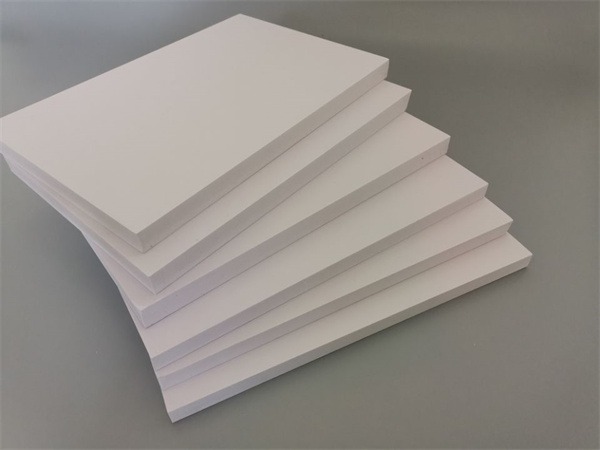
PVC foam board is a board material with PVC resin as the main raw material prepared by plasticizing and extruding foam, and adding auxiliary agents including stabilizer, foaming agent, lubricant, and foam regulator. Because of its low density, low thermal conductivity, sound insulation, flame retardancy, corrosion resistance, easy to be processed features PVC foam Sheet is widely used in building decoration, interior decoration, stencil printing, advertising, signage, computer engraving, display board, photo album board.
According to the different production processes, PVC foam board can be classified into PVC free foam board, Celuka board, and PVC Co-Extrusion Foam board.
Pvc free foam board
Pvc free foam board is a foam board produced in the process of foaming, after the molten material leaves the mold, it is cooled and shaped by the cold roller into three rollers. The production process of PVC-free foam board has a shorter cooling time and slow cooling speed, and the surface structure of PVC-free foam board is loose and linen-like without an obvious crust. PVC-free foam board can be produced by using common foam molds, and the process is relatively easy to control. The thickness of PVC-free foam board is generally between 1mm-20mm, and the density is between 0.4-0.8g/cm3.
Celuka board
Celuka board is a foamed board produced by cooling and shaping multiple shaping plates after the molten material leaves the mold during the foaming process. The Celuka board production process is fast and sufficiently cooled, which is very beneficial for the production of thick boards.
The surface of the Celuka board will produce a smooth and flat hard skin layer, and the skin layer is much harder than the core layer inside, so the surface of the Celuka board is hard and has good mechanical properties, and it is not easy to be scratched. What’s more, the Celuka board has good insulation and corrosion resistance, and the products have high precision and small thickness error, strict requirements on mold, formula, process, and raw materials.
Usually, the thickness of the Celuka board is between 1mm-40mm and the density is between 0.4-0.8g/cm3, and the density can be as high as 1.0g/cm3.
PVC co-extruded foam board
PVC co-extruded foam board is a board extruded by two machines after the molten material leaves the mold, one of which is responsible for accumulating the surface layer of the board and the other for the extrusion of the core layer. This produces a high hardness surface of the foam board. The surface of the board is smooth and glares like a mirror and is difficult to be scratched. It is widely used in decoration and construction, Usually, the density of PVC Co-Extrusion Foam board is generally between 0.45-1.0g/cm3, and the thickness can be 2mm-40mm.
With the development of society, energy and environmental issues are receiving more and more attention from society, PVC foam board with its excellent performance can replace the wood used in the furniture and decoration industry. Its production and manufacturing process do not produce pollution, and can also be recycled, so it can be called a real sense of environmental protection, energy-saving, resource recycling materials.
